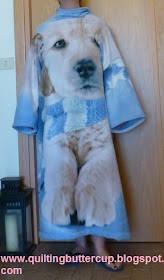This little cushion combines warmth and aromatherapy to a perfect relaxing experience. Just place it in the microwave at maximum heat for a couple of minutes and enjoy the heat and the sweet scent of lavender.
Making a cushion is easy, all you need is fabric, rice and dried lavender flowers.
Start by cutting the fabric. How big do you want your cushion to be? Mine measure 46x21 cm (appr. 18x8.5 inches).
Cut a piece of fabric that measures double the desired size (don't forget the seam allowance!). I cut my rectangle 93.5 x 22.5cm (36.5x21.5 inches).
Fold the piece over, right side to right side and close both long sides of the rectangle plus the outher thirds of the short side. The middle third of the short side will remain open (this is where you will fill in the rice and lavender).
Now turn the cushion outside out throught the opening and draw evenly spaced lines onto the surface (use a pen that you will be able to get off later).
Now mix rice and lavender flowers. To fill the cushion I used about 750g of rice and 75g of lavender.
Mix both ingredients thorougly and start to fill part of it into the cushion through the opening.
When you put enough filling for the first segment, use a long object (I used a ruler) to move the rice and lavender all the way into the cushion.
Then close the first segment sewing along the first traced line.
Continue to fill and close the following segments in the same way.
Finally fill the last segment and close the opening by hand using a blind stitch.
Now place the cushion in your microwave and within minutes you will be able to enjoy it!
Have you made a project following this tutorial? Let me know what you think. Did you like it? Was it easy to understand and to follow? Do you have any suggestions?
Write a comment or send me an email using the contact form at the bottom of the page. 














































